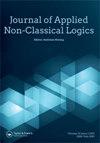Reconstructor: a computer program that uses three-valued logics to represent lack of information in empirical scientific contexts
Q1 Arts and Humanities
引用次数: 2
Abstract
ABSTRACT In this article, I develop three conceptual innovations within the area of formal metatheory, and present a computer program, called Reconstructor, that implements those developments. The first development consists in a methodology for testing formal reconstructions of scientific theories, which involves checking both whether translations of paradigmatically successful applications into models satisfy the formalisation of the laws, and also whether unsuccessful applications do not. I show how Reconstructor can help carry this out, since it allows the end-user to specify a formal language, input axioms and models formulated in that language, and then ask if the models satisfy the axioms. The second innovation is the introduction of incomplete models (for which the denotation of some terms is missing) into scientific metatheory, in order to represent cases of missing information. I specify the paracomplete semantics built into Reconstructor to deal with sentences where denotation failures occur. The third development consists in a new way of explicating the structuralist notion of a determination method, by equating them with algorithms. This allows determination methods to be loaded into Reconstructor and then executed within a model to find out the value of a previously non-denoting term (i.e. it allows the formal reconstruction to make predictions). This, in turn, can help test the reconstruction in a different way. Finally, I conclude with some suggestions about additional uses the program may have.重构器:一种计算机程序,它使用三值逻辑来表示经验科学背景下信息的缺乏
在本文中,我在形式元理论领域中提出了三个概念创新,并提出了一个名为Reconstructor的计算机程序来实现这些创新。第一个发展包括测试科学理论的形式重建的方法,包括检查范式成功应用到模型中的翻译是否满足法律的形式化,以及不成功的应用是否不满足法律的形式化。我将展示Reconstructor如何帮助实现这一点,因为它允许最终用户指定一种形式语言,输入用该语言表述的公理和模型,然后询问模型是否满足公理。第二个创新是在科学元理论中引入不完整模型(其中一些术语的外延缺失),以表示缺失信息的情况。我指定了内置于Reconstructor中的准完全语义,以处理发生表示错误的句子。第三个发展是用一种新的方式来解释确定方法的结构主义概念,将它们等同于算法。这允许将确定方法加载到Reconstructor中,然后在模型中执行,以找出先前未表示的项的值(即允许正式重构进行预测)。反过来,这可以帮助以不同的方式测试重建。最后,我对该程序可能具有的其他用途提出了一些建议。
本文章由计算机程序翻译,如有差异,请以英文原文为准。
求助全文
约1分钟内获得全文
求助全文
来源期刊

Journal of Applied Non-Classical Logics
Arts and Humanities-Philosophy
CiteScore
1.30
自引率
0.00%
发文量
8
 求助内容:
求助内容: 应助结果提醒方式:
应助结果提醒方式:


